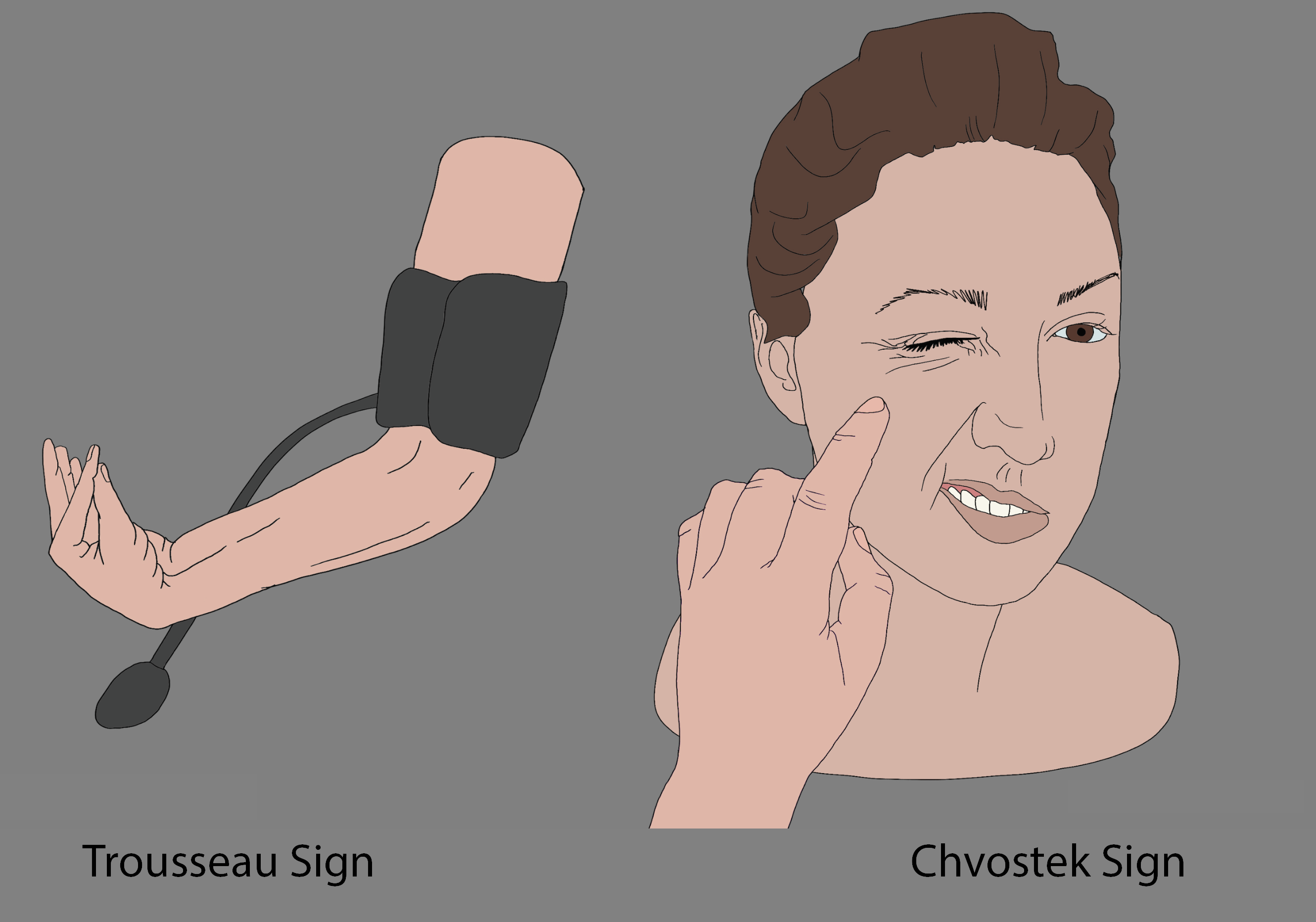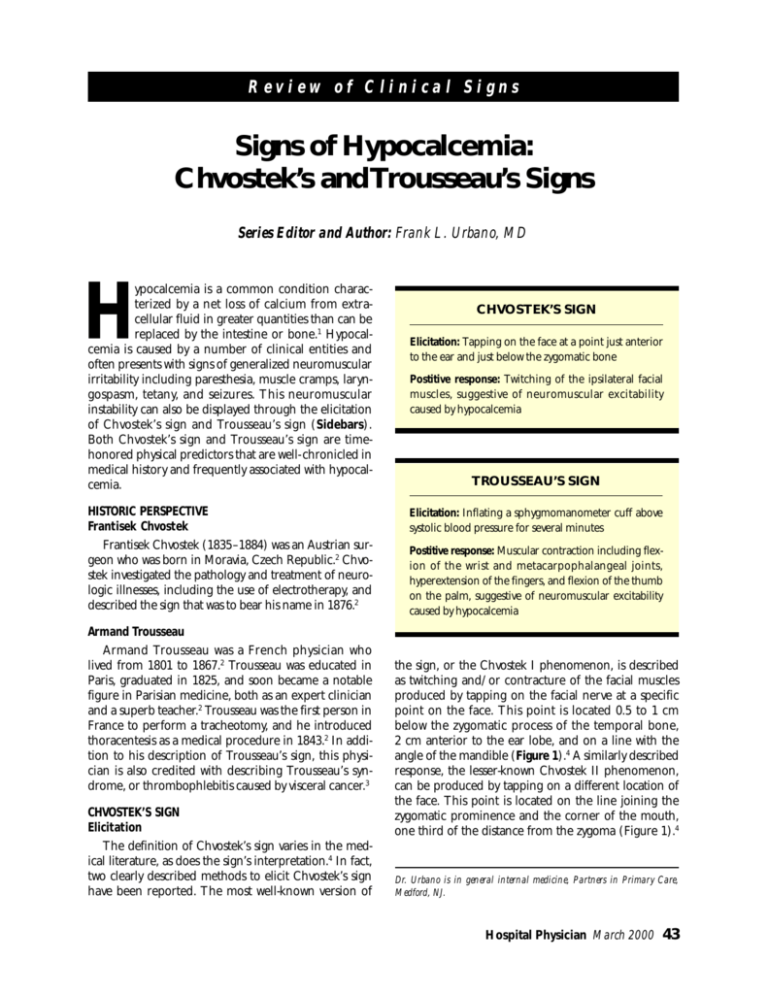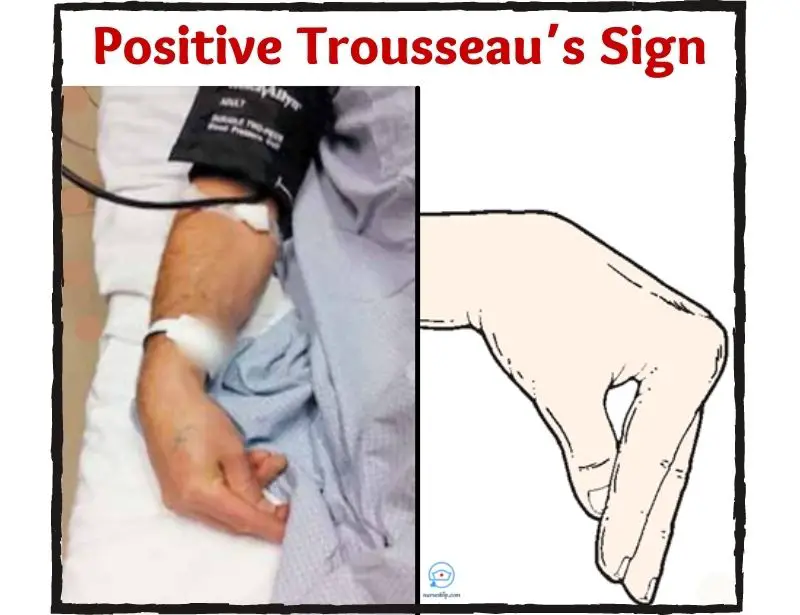
Pin on Other stuff
Physical examination revealed apparent Chvostek's sign (Figure 1A and Video 1) and Trousseau's sign (Figure 1B and Video 2), a result of postsurgical acquired hypoparathyroidism. His total.

Video Hypocalcemia Signs & Symptoms (Trousseau's & Chvostek's Signs)
Chvostek's sign is de-scribed as the twitching of facial muscles in response to tapping over the area of the facial nerve (Video 1). Trousseau's sign is carpopedal spasm that results from ischemia, such as that induced by pressure applied to the upper arm from an in-flated sphygmomanometer cuff (Video 2).

(PDF) Chvostek's and Trousseau's signs in a Case of Hypoparathyroidism
Chvostek sign is contraction of facial muscles provoked by lightly tapping over the facial nerve anterior to the ear as it crosses the zygomatic arch. This induces twitching of the homolateral facial muscles due to hyperexcitability of the nerve.

Trousseau's sign and chvostek sign MEDizzy
Chvostek's sign is a specific type of facial muscle twitching that occurs when cranial nerve VII (the facial nerve) is manually stimulated by tapping the finger over the masseter muscle of the jaw. A positive sign demonstrates hyper-excitability of the facial nerve. This is not to be confused with Trousseau's sign of latent tetany, which is.

Chvostek Sign Article
NIH HHS USA.gov Trousseau's sign for latent tetany is most commonly positive in the setting of hypocalcemia. [1] The sign is observable as a carpopedal spasm induced by ischemia secondary to the inflation of a sphygmomanometer cuff, commonly on an individual's arm, to 20 mmHg over their systolic blood pressure for 3 minutes. [1]

Two neurological test to evaluate the presence of hypocalcemia (Chvostek and Trousseau signs
Acute hypocalcemia can lead to paresthesia, tetany, and seizures (characteristic physical signs may be observed, including Chvostek sign, which is poorly sensitive and specific of hypocalcemia, and Trousseau sign).

Signs of Hypocalcemia Chvostek's and Trousseau's
A positive Trousseau's sign is defined by flexion of the wrist, the thumb, and the joints located between the palm of the hand and the fingers (i.e., metacarpophalangeal joints ), along with the extension of the fingers. What are the most important facts to know about the Trousseau sign?

Figure 031_4_4998. Chvostek sign. Illustration courtesy of Dr Shannon Zhang. McMaster Textbook
On exam, Chvostek's sign (twitching of facial muscles in response to tapping over the facial nerve. [ Table/Fig-1] and Video-1 and Trousseau's sign (carpopedal spasm induced by pressure applied to the arm by an inflated sphygmomanometer cuff. [ Table/Fig-2] and Video-2 was present. Her total calcium level was 5.5 mg/dL (normal range 9.2-11).

Mechanism of Chvostek's sign explained, associated conditions, sign value, how accurate is it
Chvostek Sign - StatPearls - NCBI Bookshelf HHS Vulnerability Disclosure In the late 1800s, Dr. Chvostek noticed that mechanical stimulation of the facial nerve (as with the examiner's fingertip, for example) could lead to twitching of the ipsilateral facial muscles. [1]

Chvostek's sign and Trousseau's sign YouTube
Symptoms and Signs Diagnosis Treatment Key Points Hypocalcemia is a total serum calcium concentration < 8.8 mg/dL ( < 2.20 mmol/L) in the presence of normal plasma protein concentrations or a serum ionized calcium concentration < 4.7 mg/dL ( < 1.17 mmol/L). Causes include hypoparathyroidism, vitamin D deficiency, and renal disease.

Video Hypocalcemia Signs & Symptoms (Trousseau's & Chvostek's Signs)
Trousseau sign is elicited in hypocalcemia when the ionized calcium level is 1.75-2.25 mmol/L. 1 The hand adopts a characteristic posture when the sphygmomanometer cuff is inflated above the systolic blood pressure within 3 minutes.

低血钙导致的Chvostek sign和Trousseau sign 哔哩哔哩
Watch on What is Chvostek's Sign? Chvostek's sign is the name given to a clinical finding associated with hypocalcemia (low levels of calcium in the blood). It appears as a twitch of the facial muscles following gentle tapping over the facial nerve in front of the ear.

(PDF) Images in clinical medicine. Chvostek's and Trousseau's signs
Chvostek's sign is the twitching of facial muscles in response to tapping over the area of the facial nerve, while Trousseau's sign is a carpopedal spasm (frequent and involuntary muscle contractions in the hands and feet) that results from ischemia (inadequate blood supply to the heart muscles), which is induced by pressure applied to the upper.

Trousseau's Sign Causes Assessment Treatment
Chvostek's and Trousseau's Signs Metrics Chvostek's and Trousseau's Signs ( Images in Clinical Medicine, N Engl J Med 2012;367:e15-e15 ). In the fifth sentence (page e15), beginning, "His total.

Signs of Hypocalcemia Chvostek's and Trousseau's Signs Semantic Scholar
Chvostek's sign was attributed initially to increased sensitivity of the facial nerve to mechanical stimuli in idiopathic epidemic tetany. 1 2 Traditionally, it is elicited by tapping on the face at a point just anterior to the ear and just below the zygomatic bone. 3 A positive response is represented by twitching of the ipsilateral facial muscles, suggesting neuromuscular excitability caused.

Chvostek’s sign test for hypocalcemia clinical sign learning diagnoseکیلشیم کی کمی کی
Trousseau's sign is a sign of tetany. (1,2) It is most often due to hypocalcemia but can occur with a normal calcium level and in other conditions. (3-7) Ischemia of the peripheral nerve trunks increases nerve excitability and causes spontaneous discharges that produce carpopedal spasm.